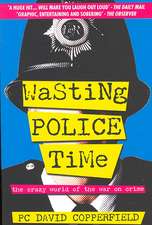Handbook of Loss Prevention and Crime Prevention
Autor Lawrence J. Fennellyen Limba Engleză Paperback – 12 feb 2020
Edited by seasoned, trusted security practitioner Lawrence Fennelly, the book features contributions by some of the most well-known experts in the field. Readers will find this book to be a trusted resource for physical security professionals, students and certification candidates who must navigate, and make sense of, today’s most pressing domestic and international security issues.
- Covers every important topic in the field, including new coverage of active shooters, terroristic threats, and the latest on wireless security applications, data analysis and visualization, situational crime prevention, and global security standards and compliance issues
- Provides a comprehensive examination on the content and skills necessary for passing the ASIS Certified Protection Professional (CPP) exam
- Features contributions from the leading, most trusted subject-matter experts in the field
| Toate formatele și edițiile | Preț | Express |
|---|---|---|
| Paperback (1) | 461.67 lei 5-7 săpt. | |
| ELSEVIER SCIENCE – 12 feb 2020 | 461.67 lei 5-7 săpt. | |
| Hardback (1) | 446.79 lei 5-7 săpt. | |
| ELSEVIER SCIENCE – 16 feb 2012 | 446.79 lei 5-7 săpt. |
Preț: 461.67 lei
Preț vechi: 609.35 lei
-24% Nou
Puncte Express: 693
Preț estimativ în valută:
88.34€ • 96.26$ • 74.44£
88.34€ • 96.26$ • 74.44£
Carte tipărită la comandă
Livrare economică 16-30 aprilie
Preluare comenzi: 021 569.72.76
Specificații
ISBN-13: 9780128164594
ISBN-10: 012816459X
Pagini: 544
Ilustrații: Approx. 100 illustrations
Dimensiuni: 216 x 276 x 31 mm
Greutate: 1.25 kg
Ediția:6
Editura: ELSEVIER SCIENCE
ISBN-10: 012816459X
Pagini: 544
Ilustrații: Approx. 100 illustrations
Dimensiuni: 216 x 276 x 31 mm
Greutate: 1.25 kg
Ediția:6
Editura: ELSEVIER SCIENCE
Public țintă
KEYWORDS: Designation, design, territorial reinforcement, natural access control, natural surveillance, image maintenance, activity program support, target hardening, geographical juxtaposition, active shooterCuprins
1. Encompassing CPTED in 2020 and Beyond2. Designing Crime Risk Management3. Designing Security and Working with Architects4. Introduction to Vulnerability Assessment5. The Security Survey and The Audit6. Vulnerability Assessment Process Inputs Establish Protection
Section A. Objectives7. Approaches to Physical Security and Deterrents8. Bringing CPTED into the 21st Century9. Environmental Criminology and Crime Control10. Problem Solving and Effective Community Policing11. Neighborhood Watch Guidelines for the Twenty-First Century12. Situational Crime Prevention and Opportunity Blocking
Section B. Planning and Evaluation13. Design and Evaluation of Physical Protection Systems14. Planning, Management and Evaluation15. Crime Analysis16. Standards, Regulations, and Guidelines: Compliance and Your Security Programs, Including Global Resources and Master Plan
Section C. Security Operations, Tools, and Technology17. Access Control, Access Badges and Biometrics Characteristics18. Intrusion Detection Systems19. Security Surveillance Systems20. Security Lighting
Section D. Technology21. Information Technology Systems Infrastructure
Section E. Delay22. Protective Barriers23. Physical Barriers24. Fences and Walls25. The Use of Locks in Physical Crime Prevention26. Safes and Vaults
Section F. Response27. Today's Security Officer and SRO28. Bomb Threats29. Internal Theft Controls30. Safe Schools and Safe Campuses31. Domestic Violence: Can It Be Stopped32. Proprietary Information33. Identity Theft34. Retail Security & Employee Theft35. High Rise Building Security36. Multi-Residential Security37. Lodging Hospitality Security38. Emergency Management39. Cargo Theft and Cargo Security40. Soft Targets
Section A. Objectives7. Approaches to Physical Security and Deterrents8. Bringing CPTED into the 21st Century9. Environmental Criminology and Crime Control10. Problem Solving and Effective Community Policing11. Neighborhood Watch Guidelines for the Twenty-First Century12. Situational Crime Prevention and Opportunity Blocking
Section B. Planning and Evaluation13. Design and Evaluation of Physical Protection Systems14. Planning, Management and Evaluation15. Crime Analysis16. Standards, Regulations, and Guidelines: Compliance and Your Security Programs, Including Global Resources and Master Plan
Section C. Security Operations, Tools, and Technology17. Access Control, Access Badges and Biometrics Characteristics18. Intrusion Detection Systems19. Security Surveillance Systems20. Security Lighting
Section D. Technology21. Information Technology Systems Infrastructure
Section E. Delay22. Protective Barriers23. Physical Barriers24. Fences and Walls25. The Use of Locks in Physical Crime Prevention26. Safes and Vaults
Section F. Response27. Today's Security Officer and SRO28. Bomb Threats29. Internal Theft Controls30. Safe Schools and Safe Campuses31. Domestic Violence: Can It Be Stopped32. Proprietary Information33. Identity Theft34. Retail Security & Employee Theft35. High Rise Building Security36. Multi-Residential Security37. Lodging Hospitality Security38. Emergency Management39. Cargo Theft and Cargo Security40. Soft Targets
Recenzii
"Larry Fennelly continues to provide the content that ensures his book will be on the front of any professional security managers practitioner’s bookshelf. This edition brings the reader the up to date with the materials and subjects needed to solve current security problems. No security practitioner’s library is complete without this handbook." --Joseph C. Nelson, CPP, Assistant Vice President, State Street Global Security"As usual, Larry Fennelly has written a comprehensive, practical guide--one that belongs on the bookshelf of the serious security practitioner. The book is readable, interesting and up to date in all respects." --John J. Fay, CPP, former Director of the National Crime Prevention Institute"I have been extremely impressed with the evolution of the content as this book moves into its next generation. It is very comprehensive and well written. The new edition now includes real time academic reference material and makes it usable as a university textbook." --Mark H. Beaudry, CPP











